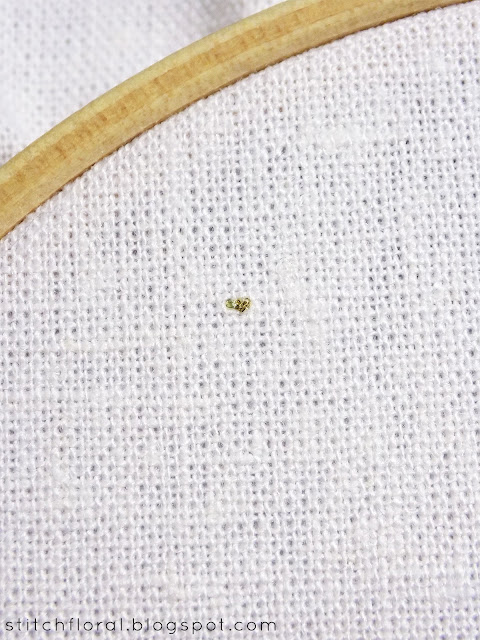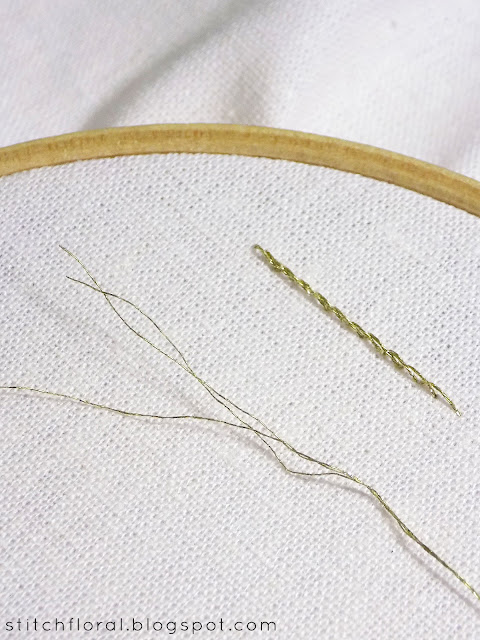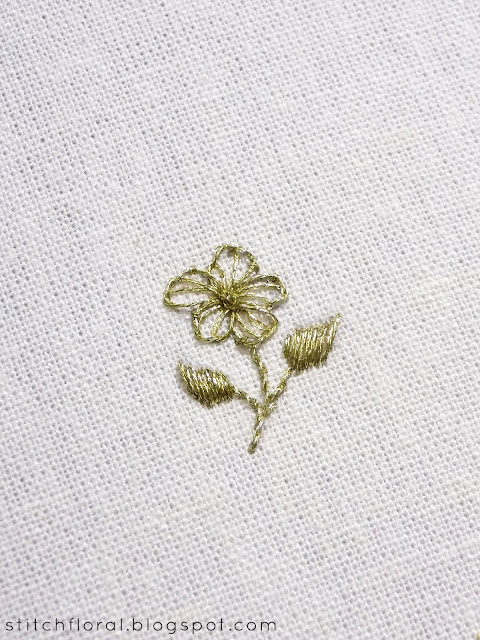Hello everyone! StitchFloral is back from winter vacations :) And we start the new year on a golden note, hehe :)
Many of us want to add some extra shine to our embroidery but I bet just as many are scarred for life by the 6-stranded metallics that you can usually find in the stores along with the regular embroidery floss.
I mean, at least for me, that was probably the worst experience in my embroidery life so far.
I was actually considering making a comparison post between the 6-stranded metallics and DMC Diamant, but I didn't find the courage in me to go through that pain again, haha.
What I'm leading to, is if you want to use metallics in your stitching, I can definitely recommend DMC Diamant. It is SO MUCH easier to work with and the result doesn't disappoint.
But, like always, there are a few points and tips to discuss, so let's get to it.
DMC Diamant
Before we begin, I just want to mention, that it is not an ad and I'm not getting anything out of the review. It's all purely my experience and opinion.
Here's DMC's description of this thread:
“Diamant Metallic thread is a smooth single strand metallic thread that glides through nearly any fabric. Soft and tangle-free. One strand is equivalent to two strands of DMC embroidery floss. Made up of viscose, rayon and metallic polyester. The thread is soft and keeps its twist when used. DMC Diamant can be used on all kinds of fabric including cotton, linen, satin, silk and gives a precise and even coverage. Ideal for traditional embroidery and cross stitch. Each spool is 38.2 yds”
DMC Diamant is a spoon of a single strand thread, but this one strand consists of 3 plies. It passes through the fabric with ease and, although it IS a bit more rigid than regular cotton floss, it is still pliable enough to work various stitches with it.
Let's practice a little to understand thread better in action.
Starting thread
First of all, I want to note that the thread frays a lot.
The 3 plies that form a strand are not twisted as firmly together as in cotton floss. So when you cut it, they start separating and going different directions at once.
You will not have troubles passing the thread through the needle eye, though, as long as the eye is big enough.
As for starting the thread, I usually use anchoring stitches and it workes just great. Make a tiny stitch in the area that will be covered, then add a tiny stitch next to it and go to the starting point of your stitching.
Stitching with DMC Diamant
So, let's see how the stitches worked with this thread look like.
As you see, the line of stem stitch and quite neat and nice, and I can say there wasn't any trouble working it.
If you look at it from this angle, however, you can see that the stitches rise quite high above the fabric. This is something to be aware of when you work with this metallic. The thread IS a little rigid so the stitches will rise to an extent.
Also, something to be aware of:
As you stitch, the appearance of the thread doesn't wear down that much (that is, if you cut it in a correct length, of course. Around 1 forearm is usually the length I use with this metallic). But the end of the thread does wear down and fray more and more. I trim the end gradually because you can't use the frayed part anyway.
French knots are made with 2 wraps around the needle. They are a little challenging to work with this thread because it is stiff, after all. But still possible, as long as you hold the working end of the thread carefully.
Ending thread
To end this metallic, it's better to make a knot on the other side.
Pass the thread under a couple of stitches.
As you do that, slide the needle through the loop.
And pull the thread carefully until a knot forms. After that pass the needle under a couple more stitches and snip it.
It will hold fast enough to not undo. But if you plan to use it on some items that will be in use (like a clutch, or a bag, or a cap) then I personally would go for 2 knots to be safe.
Here's more that you can create with this thread. As you see, it works fine with buttonhole stitch and satin stitch as well.
Well, if I'm completely honest, satin stitch is a bit of a struggle, because it is hard to bring the needle in such close proximity of the previous stitch. And also because the stitches rise above the fabric, so if you look from a different angle, it looks like a dome, haha.
Don't be scared to try this metallic out! It can be used alone to create some charming pattern, or you can use it along with the cotton floss to add some spark and shine. There are many possibilities to how you can utilize this thread, so feel free to explore. I can just assure you that this thread will grant you a more pleasant experience and more gratifying result than the 6-stranded metallics, haha.


























I love DMC Diamant too! So far, I've only used it in cross-stitch. It is a bit springy and tends to stand off the fabric but the shine is gorgeous and it shows the stitch definition so much better than the stranded metallic floss. I actually enjoy Light Effects floss too, although it is difficult to stitch with at times and requires a bit of patience. I love your little gold flower embroidery, so pretty!
ReplyDeleteI haven't tried Light Effects! Will be on my list now :) Yeah, Diamant is hard to even compare to the stranded metallic, haha.
DeleteThank you!
Metallic Threads
ReplyDeleteHelp! I tried Diamant for the first time this past week. I don't want it to be the last - but I found it very frustrating. The fraying mentioned in the article is a real problem. No matter how short I cut it, knotting is a real problem (especially on teh back). What will make this product easier to use?
ReplyDeleteHi!
DeleteMetallic thread WILL fray, please don't expect from them the same performance as from stranded cotton! There are just ways on how to minimize it, but it will only do so much, because at the end of the day, metallics are supposed to be used on top of the fabric by couching the thread, not really going up and down through the fabric.
The ways to minimize fraying: cutting thread shorter, using a needle with a bigger eye, using thread conditioneer (I haven't tried one so I'm not really qualified on speaking on its benefits, I only know form theory).
But in any case, fraying WILL occur, that's just how it is ❤
This advice was very helpful to me - new to this product. Thank you!
ReplyDeleteThank you for explaining this to me. I just got the product and was going to use it like I would the DMC cotton. Thanks for helping me avoid this mistake. I am just enjoying this Art form and working on 25-count Lenin Fabric.
ReplyDelete